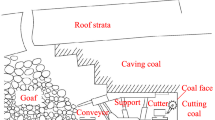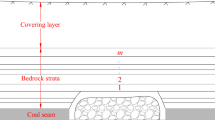Abstract
Structure stability analysis of rock masses is essential for forecasting catastrophic structure failure in coal seam mining. Steeply dipping thick coal seams (SDTCS) are common in the Urumqi coalfield, and some dynamical hazards such as roof collapse and mining- induced seismicity occur frequently in the coal mines. The cause of these events is mainly structure instability in giant rock pillars sandwiched between SDTCS. Developing methods to predict these events is important for safe mining in such a complex environment. This study focuses on understanding the structural mechanics model of a giant rock pillar and presents a viewpoint of the stability of a trend sphenoid fractured beam (TSFB). Some stability index parameters such as failure surface dips were measured, and most dips were observed to be between 46° and 51°. We used a digital panoramic borehole monitoring system to measure the TSFB’s height (ΔH), which varied from 56.37 to 60.50 m. Next, FLAC3D was used to model the distribution and evolution of vertical displacement in the giant rock pillars; the results confirmed the existence of a TSFB structure. Finally, we investigated the acoustic emission (AE) energy accumulation rate and observed that the rate commonly ranged from 20 to 40 kJ/min. The AE energy accumulation rate could be used to anticipate impeding seismic events related to structure failure. The results presented provide a useful approach for forecasting catastrophic events related to structure instability and for developing hazard prevention technology for mining in SDTCS.
Similar content being viewed by others
References
F.H. Ren, X.P. Lai, and M.F. Cai, Dynamic destabilization analysis based on AE experiment of deep-seated, steep-inclined and extra-thick coal seam, J. Univ. Sci. Technol. Beijing, 15(2008), No. 3, p. 215.
S.J. Miao, X.P. Lai, and F. Cui, Top coal flows in an excavation disturbed zone of high section top coal caving of an extremely steep and thick seam, Min. Sci. Technol. China, 21(2011), No. 1, p. 99.
Z.Y. Tan and M.F. Cai, Measurement and study of the distributing law of in-situ stresses in rock mass at great depth, J. Univ. Sci. Technol. Beijing, 13(2006), No. 3, p. 207.
T.K. Lu, Y.Z. Liu, and F.S. Xu, Deformation and failure of stratified weak roof strata of longwall roadway, J. Univ. Sci. Technol. Beijing, 14(2007), No. 5, p. 387.
A. Vakili and B.K. Hebblewhite, A new cavability assessment criterion for longwall top coal caving, Int. J. Rock Mech. Min. Sci., 47(2010), No. 8, p. 1317.
V.V. Khanzode, J. Maiti, and P.K. Ray, A methodology for evaluation and monitoring of recurring hazards in underground coal mining, Saf. Sci., 49(2011), No. 8–9, p. 1172.
J.G. Zhang, Z.Q. Zhao, and Y. Gao, Research on top coal caving technique in steep and extra-thick coal seam, Procedia Earth Planet. Sci., 2(2011), p. 145.
X.P. Lai, P.F. Shan, J.T. Cao, H. Sun, Z.Y. Suo, and F. Cui, Hybrid assessment of pre-blasting weakening to horizontal section top coal caving (HSTCC) in steep and thick seams, Int. J. Min. Sci. Technol., 24(2014), No. 1, p. 31.
Y. Luo and Z.W. Shen, Study on orientation fracture blasting with shaped charge in rock, J. Univ. Sci. Technol. Beijing, 13(2006), No. 3, p. 193.
Y.K. Ran, L.C. Chen, J. Shen, J. Li, and H.L. Gong, Xishan fault group near Urumqi city and paleo-earthquake identification on reverse fault, Seismol. Geol., 29(2007), No. 2, p. 218.
C.X. Yang, Z.Q. Luo, G.B. Hu, and X.M. Liu, Application of a microseismic monitoring system in deep mining, J. Univ. Sci. Technol. Beijing, 14(2007), No. 1, p. 6.
J. Christer Andersson and C. Derek Martin, The Äspö pillar stability experiment: Part I. Experiment design, Int. J. Rock Mech. Min. Sci., 46(2009), No. 5, p. 865.
J. Christer Andersson, C. Derek Martin, and H. Stille, The Äspö pillar stability experiment: Part II. Rock mass response to coupled excavation-induced and thermal-induced stresses, Int. J. Rock Mech. Min. Sci., 46(2009), No. 5, p. 879.
G.S. Esterhuizen, D.R. Dolinar, and J.L. Ellenberger, Pillar strength in underground stone mines in the United States, Int. J. Rock Mech. Min. Sci., 48(2011), No. 1, p. 42.
W. Korzeniowski, Rheological model of hard rock pillar, Rock Mech. Rock Eng., 24(1991), No. 3, p. 155.
M. Rinne, B.T. Shen, and T. Backers, Modelling fracture propagation and failure in a rock pillar under mechanical and thermal loadings, J. Rock Mech. Geo. Eng., 5(2013), No. 1, p. 73.
E. Ghasemi, K. Shahriar, and M. Sharifzadeh, A new method for risk assessment of pillar recovery operation, Saf. Sci., 48(2010), No. 10, p. 1304.
H.Z. Zhu, P. Liu, and Z.Y. Tong, Numerical simulation research and application on protected layer pressure relief affection under different coal pillar width, Procedia Eng., 84(2014), p. 818.
C.P. Please, D.P. Mason, C.M. Khalique, J.M.T. Ngnotchouye, A.J. Hutchinson, J.N. van der Merwe, and H. Yilmaz, Fracturing of an Euler-Bernoulli beam in coal mine pillar extraction, Int. J. Rock Mech. Min. Sci., 64(2013), p. 132.
R.K. Wattimena, S. Kramadibrata, I.D. Sidi, and M.A. Azizi, Developing coal pillar stability chart using logistic regression, Int. J. Rock Mech. Min. Sci., 58(2013), p. 55.
R. Singh, A.K. Singh, J. Maiti, P.K. Mandal, R. Singh, and R. Kumar, An observational approach for assessment of dynamic loading during underground coal pillar extraction, Int. J. Rock Mech. Min. Sci., 48(2011), No. 5, p. 794.
A.K. Singh, R. Singh, J. Maiti, R. Kumar, and P.K. Mandal, Assessment of mining induced stress development over coal pillars during depillaring, Int. J. Rock Mech. Min. Sci., 48(2011), No. 5, p. 805.
X.H. Chen, W.Q. Li, and X.Y. Yan, Analysis on rock burst danger when fully-mechanized caving coal face passed fault with deep mining, Saf. Sci., 50(2012), No. 4, p. 645.
M. Najafi, S.E. Jalali, A.R. Yarahmadi Bafghi, and F. Sereshki, Prediction of the confidence interval for stability analysis of chain pillars in coal mines, Saf. Sci., 49(2011), No. 5, p. 651.
Author information
Authors and Affiliations
Corresponding author
Rights and permissions
About this article
Cite this article
Lai, Xp., Sun, H., Shan, Pf. et al. Structure instability forecasting and analysis of giant rock pillars in steeply dipping thick coal seams. Int J Miner Metall Mater 22, 1233–1244 (2015). https://doi.org/10.1007/s12613-015-1190-z
Received:
Revised:
Accepted:
Published:
Issue Date:
DOI: https://doi.org/10.1007/s12613-015-1190-z




